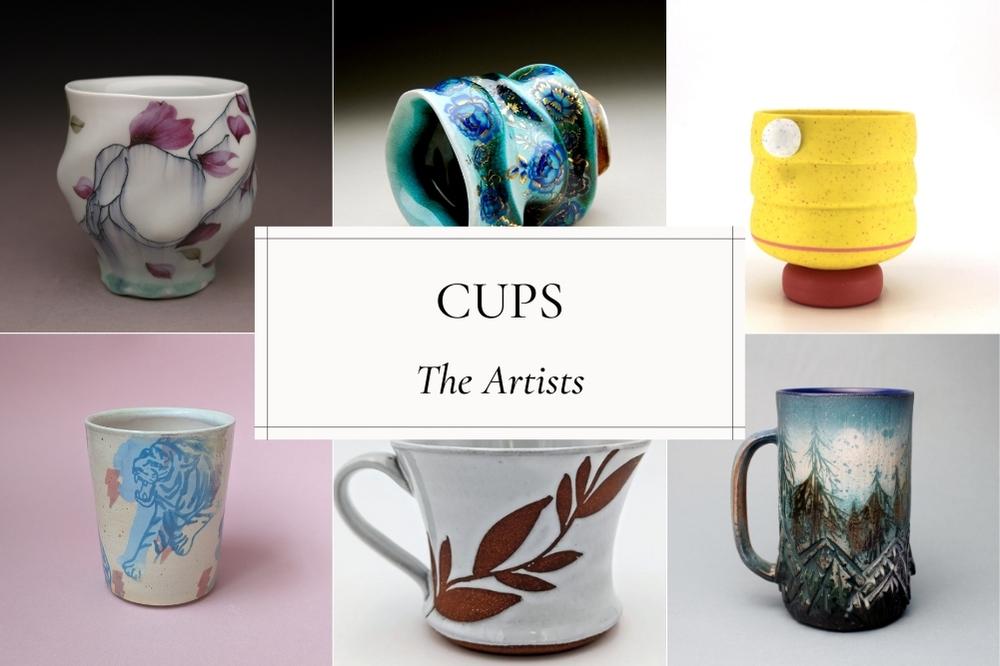
Cups is a group exhibition showcasing talented ceramic artists from all over the country. Each artist created five new cups in their unique style of functional pottery for this event, highlighting the captivating legacy of outstanding ceramics at the Lawrence Arts Center.
Click each artist’s name to view their website.
Participating Artists

Chris Alveshere’s pots are an investigation of items he finds curious, feels sentimental towards, or objects he finds humor in. This investigation could come from the object’s surface, form, or, most often, from intriguing proportion or scale. Forms, parts, clay, and glaze colors are curated to be strong and inventive with high contrast. Inflated swells, large knobs, and enamel-like sheens from sanded surfaces and glazes create exaggerated, vibrant pieces.
Chris visualizes pots in everyday objects and places, seeing the potential of form and color in everything from vintage wooden toys to a pile of Skittles or wandering thrift stores. This inspiration has steered him into making pots other than traditional dinnerware. He is making work for the countertop and pots that allow many functions. Foremost is an intention to make pieces with a sense of whimsy, humor, and color. Audacious, lively, and cheeky pieces with attitude and intention.
Chris Alveshere is an artist, educator, and co-owner of Workroom Montana, a community arts space in Missoula, MT. He currently teaches art education and ceramics at the University of Montana, in addition to adult and youth community education classes. Originally from North Dakota, Chris received undergraduate degrees in ceramics and art education from Minnesota State University in Moorhead, MN and his MFA in ceramics from Alfred University.
___________________________________________________________________________________________________________________________________________
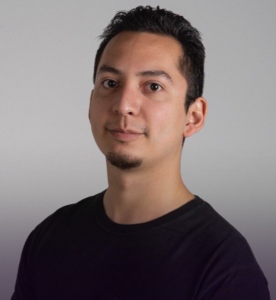
Juan Barroso’s work is about Mexican labor and Mexican immigrants’ plight, struggle, hope, and heritage. With the current political administration enforcing policies that dehumanize and force immigrants into the shadows, recognizing an immigrant’s humanity is vital. Notions of us or them deteriorate, and it becomes clear that we are all working and fighting to provide shelter and a decent meal for ourselves and often a family. As the son of immigrant parents, Juan hopes to pay homage to his people and the dignity of their labor. He mixes 2-dimensional imagery, influenced by personal narratives, with 3-dimensional functional forms.
Barroso was born in Oklahoma and grew up in San Miguel Octopan, Guanajuato, Mexico. He received his BFA in art at the University of Oklahoma and his MFA in ceramics from the University of North Texas in Denton, TX. He received the Ceramics Monthly Emerging Artist Award in 2020. Companion Gallery represents his ceramic work. Barroso currently lives and works in Princeton, Texas.
___________________________________________________________________________________________________________________________________________
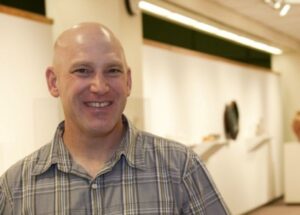
Ben Bates seeks to foster a dialogue between tradition and innovation. Drawing upon ancient art techniques, he embraces the wisdom of past generations while pushing the boundaries of contemporary aesthetics and experimentation. By embracing tradition and innovation, he hopes to contribute to the rich tapestry of ceramic art, bridging the gap between the past and the present.
Ben Bates was born and raised in Southern California and earned his BFA at Kansas City Art Institute and his MFA at Southern Illinois University Edwardsville. His work has been widely exhibited and is part of numerous museums, galleries and private collections. Ben has over 27 years of experience in the arts. He has been an artist, teacher and curator in the Chicago Land area since 1998. Ben lives in Lake Zurich, IL and is currently a Studio Artist and Ceramics Instructor at the College of Lake County in Grayslake, Illinois.
___________________________________________________________________________________________________________________________________________
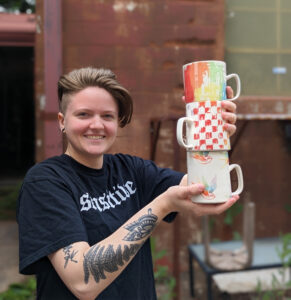
Each of Meredith Bradley’s cups is wheel thrown and screen printed with underglaze drawings empowering her – and she hopes you feel the same. Her hope for these pieces is that you drink your morning coffee from one of these mugs and are pumped to take it on – whatever it is. Pieces celebrate a connection – between maker and form – between user and life’s small moments that often pass by too fast and unnoticed.
Meredith Bradley is a ceramics designer living in Atlanta, GA. She loves clay, illustration, and color. Her focus is on small-batch ceramics that exhibit her skills in design layout patterns + screenprinting. Meredith began her interest in ceramics in high school but went on to study marketing at Georgia State University. After college, she began a residency at MudFire and has been working full-time in clay since the beginning of the pandemic in 2020.
___________________________________________________________________________________________________________________________________________
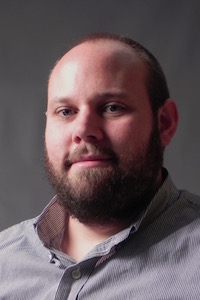
For decades, Jeff Campana has been exploring the possibilities that arise from the deconstruction and reconstruction of pottery forms. His reasons and methods for doing this have evolved over the years, and these cups are the latest in that series of work. Using digital tools, Jeff generates forms and dissolves them into a series of left and right movements, the language of the 3D printers he uses to bring the objects into physical form. As smooth curves are broken down into these movements, patterns emerge that are a natural product of the form being broken down. Jeff develops new forms in order to learn more about how these patterns emerge and how they relate to both the form and the disintegration of it through the matrix of machine movements. Also, you can drink from them.
Jeff Campana is an artist, designer, and full-time Associate Professor of Art at Kennesaw State University in suburban Atlanta. Prior to his appointment there, he was a long-term Artist in Residence at the Archie Bray Foundation in Helena, Montana. Additionally, he has been a short-term resident artist at Red Lodge Clay Center and Studio 740. He has held teaching positions at Indiana University Southeast, University of Louisville, and Bennington College. He received his BFA in Art, with an emphasis on ceramics, at the University of Wisconsin-Whitewater and his MFA in Ceramics at Indiana University-Bloomington.
___________________________________________________________________________________________________________________________________________
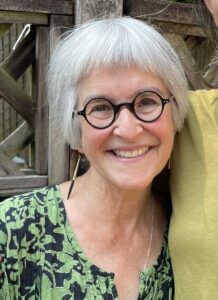
A pot is like a handshake from the maker to the user.
Victoria Christen intends for her pots to function at several levels for herself and the user. First, she strives to make everyday objects for the home, pieces that individuals use in the supposedly mundane activities of their lives. She hopes her cups, bowls, cake platters, and containers emphasize the beauty and significance of these daily rituals. On another level, she intends for her pots to embody her experiences, attitudes, and values. Victoria’s work is both thrown and constructed, intuitive and patterned, self-conscious and flamboyant—full of references to her seamstress mother’s use of patterns and tucks to make highly functional creations infused with her passion, to her father’s work as both a machinist and a maker of folk art; to her own paradoxical desire for both order and freedom; and for her pots as both containers/dispensers of everyday materials and as metaphors for the body as both receiver and giver. While she does not intend others to share in all of these meanings, she hopes that the personal level of the work will free users to perceive themselves in these objects.
Victoria Christen lives in Portland, Oregon, where she is a full-time studio potter. She has been a resident artist at Guldagaard, the International Ceramics Research Center in Denmark and the Archie Bray Foundation in Montana. She has given many workshops across the United States. Victoria has received an NEA Regional Visual Arts Fellowship Award, two Minnesota Arts Board Grants, and a travel grant to Japan. She received her MFA from the University of Minnesota.
___________________________________________________________________________________________________________________________________________
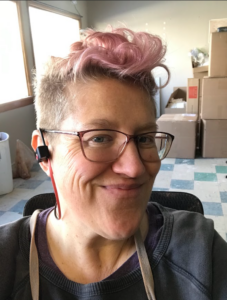
Sunshine Cobb wants her work in clay to represent growth and accomplishment, in which she believes reminiscence and nostalgia play a part. She relies on texture and color to create a sense of motion and time in her work. She hopes to instill a sense of age, like one finds apparent in discarded objects, to infuse feelings of nostalgia and wanderlust in her ceramic objects. By exploring and creating vessels kept within arm’s reach, Sunshine hopes to communicate how an object’s significance can grow and change depending on a person’s life path. And how the relationship between function and ornament shifts throughout a day, week, and year. Through form and surface, her goal is to communicate a sense of home and memory and to evoke that feeling of wanderlust that has informed her life and visual sensibilities.
Sunshine Cobb (pronouns she/they) is a studio artist living in Helena, MT; she specializes in handmade functional pottery. She frequently travels (online these days) the country as an invited lecturer and demonstration artist. They are considered an important contemporary functional potter, hailed in academic and commercial circles, and consistently featured in art exhibitions throughout the country. With a strong social media following and online media presence, she represents an innovator in online business models in the ever-changing ceramics field and a leading advocate for functional art in modern living. She has also authored two books, “Mastering Hand Building” and “A Beginners Guide to Hand Building” by Voyager Press.
___________________________________________________________________________________________________________________________________________

Most of Nick DeVries’ work originates on the potter’s wheel and are forms based on a tradition of function and use. He loves how functional pots can draw people in; they can be disarming and unassuming in their overt utility. Pots call out to be held, used, and examined like they have a specific gravity. His current body of work is made from porcelain, and he often works in a reductive fashion, throwing heavier pieces, then altering, rasping, and carving the pots to reveal the final forms. Nick enjoys balancing large areas of subtle texture and color with small additions: stamps and other details that suggest windows or doorways. These forms and small details reference architecture and structure while the surfaces borrow from nature. Subtle textures suggest grass or bark; areas of microcrystalline glaze reference the random beauty of nature: lichens growing on a rock outcropping, the subtle coloration of river rock, and the random intricacies of a leaf.
Nick enjoys juxtaposing architectural and structural qualities with surfaces referencing the natural world. He has always been drawn to human-made structures and objects that nature has affected. He is interested in how we interact with nature, sometimes sustainably and other times in more contradictory and destructive ways. We attempt to tame, claim, and use the natural world around us, but nature always pushes back. Paint peels, metal rusts, and buildings crumble; we are constantly being reminded that we are not entirely in control; we are no masters.
Nick DeVries has been working in ceramics for the past 19 years. He studied at St John’s University, where in 2001 he finished a Bachelor’s Degree in Art, concentrating on painting and ceramics. Since college, Nick has worked as a production potter for a Minneapolis bases pottery, taught courses at the Edina Art Center and Northern Clay Center, and has pursued his studio ceramic work. He exhibits his work in galleries nationally. Currently, he lives in Brainerd, MN, where he works full-time as a ceramic artist. DeVries is represented by ceramics galleries nationally and has shown his work in numerous group and solo exhibitions.
___________________________________________________________________________________________________________________________________________

Paul Donnelly is interested in functional pottery because of its long history and proximity to humankind. Through use and display, pots will impart meaning that will change during the user’s relationship with the work. The objects we interact with daily can conjure experiences in our lives, often becoming an article of sentiment. Both architectural and natural settings inspire the pieces that he produces. Paul intends to exploit the beauty of ceramic materials as a means to draw comparisons to these ideas without replicating them directly or realistically. Most of his works are created as systems to coordinate how the object operates by itself or within a larger arrangement of components. Investigation into design and function is an essential aspect of his practice. The works that he creates are intended for a specific function or made for a particular purpose. Paul is interested in using various forming techniques such as wheel throwing, hand-building, and slip-casting in conjunction with 3D modeling to create work. Oftentimes, he utilizes these techniques within the same piece to blur the concepts and associations to individuality and mass production. He likes finding a balance within his work where the evidence of the “hand” is sometimes present and other times fleeting, yet all of the pieces speak of one of the potter’s greatest strengths…individuality.
Paul Donnelly, Professor of Ceramics at the Kansas City Art Institute, is a studio potter who uses slip cast and wheel-thrown components to create decorative pottery that often serves a specific purpose. His practice explores notions of architecture and how work functions as a system within our personal space and everyday lives. He often uses digital technologies to prototype, design and decorate pieces while also striving to reveal evidence of the handmade within his work.
He received his BFA from Edinboro University of Pennsylvania and his MFA from the New York State College of Ceramics at Alfred University in New York.
His work has been featured in numerous publications such as Ceramics Monthly, Pottery Making Illustrated and Ceramics Art & Perception. He has exhibited nationally and internationally and participated in residency programs at The LH Project in Joseph, OR, The Clay Studio in Philadelphia, The Pottery Workshop in Jingdezhen, China and Watershed Center for the Ceramic Arts in Newcastle, Maine.
___________________________________________________________________________________________________________________________________________
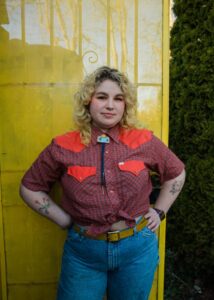
Anika Major’s pottery embodies issues of queer and romanticized idealism of stereotypes from her American Western/Texas roots. Camp, non-traditional lesbian femininity, and domestic comfort are key themes explored through the drawings of heroines that stretch across her work. Her background in painting enabled her desire to depict flamboyant self-expression and a desire to be seen, present, and understood by her peers. Anika embraces the image of the feminine, overly glamorized cowgirl to convey romance, strength, and individuality within her work.
The colorful surfaces are built using underglaze to add watercolor-like layers to create painterly images. The color palette is warm and features an array of heavily saturated skin tones; each character carries colorful aesthetics with bright makeup and flamboyant clothing. Anika’s surfaces are visually full of bold colors, with resting points of white clay underneath. The matte clear glaze of her pots highlights the vivid colors with a soft, sugary finish. The various surface applications, like underglaze transfers and sgraffito carving, create a layered environment that allows discovery with each turn.
Anika uses wheel throwing and handbuilding techniques to create pottery that feels inviting and offers the viewer an open narrative to craft their own story. She enjoys the two-dimensionality of her images on three-dimensional objects and creating objects that are best explored when used. Anika’s goal is to bring people together using her pottery, to facilitate the sharing of meals, and to create discussion, ritual, and intimacy.
Anika Major is a Texas-born ceramic artist living in Seattle, Washington. Anika graduated from the University of North Texas with a BFA in ceramics and painting. She moved to Seattle in 2018 to be an assistant at Rat City Studios to artist Deb Schwartzkopf. Anika has since become the studio manager at sister studio, Rain City Clay. Anika has taught clay classes in the greater Seattle area for the last four years and maintains a full-time studio practice creating thrown and handbuilt functional pottery. She combines her love of clay and figure painting in her colorful painted pots. Her pots’ shapes imitate the human body’s lumpiness, and her surfaces come alive with expressive and flamboyant heroines. Anika’s narratives of romance and queer domestic comforts are informed by her affinity for the pageantry of the rodeo and the symbolism of the glamorous and feminine cowgirl.
___________________________________________________________________________________________________________________________________________
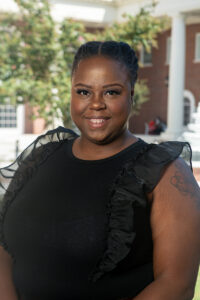
Ashlyn Pope is Gullah, a descendant of the enslaved, born into a line of abused Black women, and she inherited near identical assaults on her female Black body. Using her story as a base, Ashlyn’s practice involves drawing connections between her personal experiences and where they intersect with the experiences of broader groups of individuals within the Black community. She uses ceramics, textiles and printmaking processes in various ways to speak to a narrative of mental and physical confinement and limitation of the Black body throughout American history while simultaneously expressing pride in and honoring the beauty of the Black community—a beauty maintained despite many barbarisms levied against us.
Within her work, she expresses the human form, most commonly ceramic vessels, to talk about the Black human condition. Using sculptural and functional archetypes of the human body, Ashlyn employs wheel-throwing and hand-building techniques to create vessels to enfold African and African American culture and ceramic history. Some of her forms hemorrhage colonialism and have crowns to reclaim self-love. Some forms have patches of delftware-inspired cotton designs with dots and dashes reminiscent of historical tribal markings.
All of Ashlyn’s works use elements of Sweetgrass baskets as a way to address culture as a foundation of who we are but also to honor and uplift her ancestors’ stories. Sweetgrass baskets were a tool created in Africa. The technology of the forms was brought to America in the minds of the slaves to assist in the cultivation of rice that they used during slavery in South Carolina. Over time, the Gullah people turned a tool that was a reminder of a historical blemish in American history into an art form to aid in supporting their families. These elements allow Ashlyn to connect to her familial culture, satisfying her need to preserve her identity.
Ashlyn Pope is an educator and a ceramic and textile artist of Gullah descent. Ashlyn was born and raised in Morristown, New Jersey; however, her ancestry is from South Carolina. Ashlyn’s professional work is centered around the human figure and speaks to collective and personal experiences of being an African American and a Gullah woman in the contemporary world. Ashlyn earned her undergraduate degree from Kennesaw State University. There, she received her BFA in Ceramics and Printmaking in 2013. She completed her Master’s in Ceramics at Pennsylvania State University in 2019. Ashlyn served as an Artist-in-residence at the Lawrence Arts Center from 2019-2021 in Lawrence, Kansas. Currently, Ashlyn is an Assistant Professor in 3D foundations at Coastal Carolina University in Myrtle Beach, South Carolina.
___________________________________________________________________________________________________________________________________________

Dow Redcorn has been making functional ceramics for approximately fifteen years and is primarily a self-taught artist; however, he learned many techniques through workshops and community studio demonstrations. The natural world of forests, deep woods, and the atmospheres surrounding them are all sources of his inspiration. His artwork reflects this through his use of trees, acorns, leaves, stumps, and the imagery and design used in the Osage Tribes’ traditional clothing. He appreciates creating functional ceramics for food and drink as it appeals to his nature to create spaces for sharing meals and conversation. “It is really about providing for others, I think. My partner and I often cook for friends and family, and these items for food and drink are really in the service of people.”
His forms are made of white and red stoneware, primarily thrown and carved. Layered techniques, including airbrushing, brushwork, silk-screening, and decals, create a mix of reality and atmospheric fantasy. They are finished with transparent gloss or matte glaze and fired in oxidation to cone five.
___________________________________________________________________________________________________________________________________________

Amy Smith throws porcelain forms that celebrate movement inspired by natural forces, like the wind and waves, and more intimate allusions, like running, dance and the human figure. Her soft work is intended to be calming and sensual. It celebrates the beauty, power and allure of women.
Amy Smith earned her BFA from Ohio University in Athens, Ohio and her MFA from the University of Nebraska-Lincoln. She has been a resident artist at The Hambidge Center for the Creative Arts & Sciences, Red Lodge Clay Center, North Dakota State University, and the University of Nebraska-Lincoln. Her work has been featured by CFile.daily, The Clay Studio, Craft in America Center, and has been published in Clay Times and Ceramics Monthly. Currently, Smith teaches Ceramics at Truman State University in Kirksville, MO.
___________________________________________________________________________________________________________________________________________
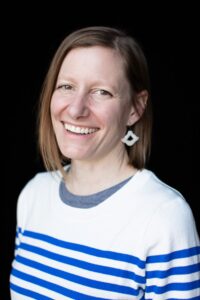
Kyla Strid’s pots are studies of small everyday occurrences, mostly from the garden and the kitchen. They exist in the background, waiting to elevate whatever they hold, be it wine, flowers, fruit, utensils, or a houseplant. The colors, textures, and surfaces of Kyla’s pots are a nod to and complement whatever they are meant to hold.
She wants to stretch quiet, fleeting moments and have them linger a bit longer.
Kyla Strid (she/her) was born and raised in Anchorage, Alaska. She earned a BFA in ceramics from the University of Alaska Anchorage in 2007 and an MFA from Ohio University in 2013. Additionally, she studied at Alfred University and the University of Nebraska-Lincoln. Kyla worked with Andy Brayman in Kansas City as a technician for Easy Ceramic Decals and the Matter Factory. She has worked as a resident artist at the Clay Studio of Missoula, Red Lodge Clay Center, and most recently at Guldagergaard International Ceramic Research Center in Denmark. Kyla is also the 2013-2014 Lawrence Arts Center ceramics artist-in-residence.
___________________________________________________________________________________________________________________________________________
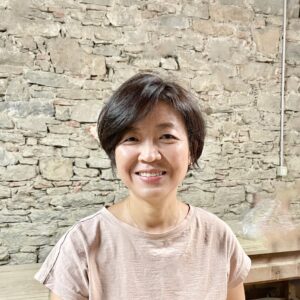
Minsoo Yuh is fascinated by the spontaneous lines, forms, and spaces she finds in nature and objects and the depth and character within them that show the passage of time. Minsoo is also inspired and influenced by traditional Korean ceramics, which embrace the beauty of simplicity, vitality, profoundness, and imperfections. This intrinsic beauty, which requires time, dedication to mastering techniques, and understanding the materials and spontaneity of the process of creation, is what she values and strives for in her work.
Regarding state of mind and physical creativity–spontaneity and vitality empowered by balance and harmony are the most essential elements of her work process. Minsoo’s work reflects her journey of self-examination and personal growth, exploring the depth of humanity, nature, and life through the inspiration derived from the intrinsic quality of clay and nature’s elements.
Minsoo Yuh was born and raised in Seoul, Korea. She earned her BFA and MFA in ceramics from Hongik University. After completing her education, Minsoo relocated to the United States and has since been working with clay. Currently based in Athens, GA, Minsoo thrives as a full-time studio potter while teaching workshops and classes. She presents her work nationwide through gallery exhibitions and pottery tours while actively participating in various art residencies.
